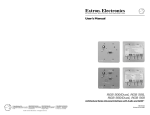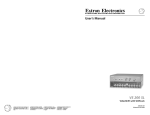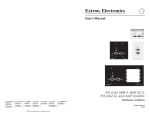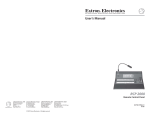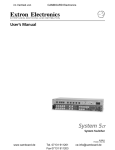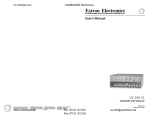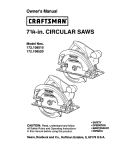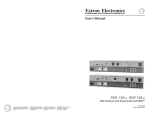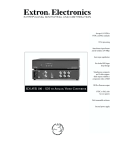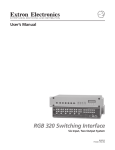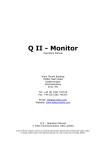Download CD 800 - Extron Electronics
Transcript
User’s Manual
CD 800
Quad-Standard Decoder
EXTRON ELECTRONICS/RGB SYSTEMS, INC.
1230 South Lewis Street, Anaheim, CA 92805
800.633.9876 714.491.1500 FAX 714.491.1517
USA
EXTRON ELECTRONICS, EUROPE
Beeldschermweg 6C, 3821 AH Amersfoort
+31.33.453.4040 FAX +31.33.453.4050
The Netherlands
EXTRON ELECTRONICS, ASIA
41B Kreta Ayer Road, Singapore 089003
+65.226.0015 FAX +65.226.0019
Singapore
EXTRON ELECTRONIC INFORMATION
EXTRONWEB™: www.extron.com
EXTRONFAX™: 714.491.0192
24-hour access — worldwide!
68-374-01
Printed in the USA
Precautions
Safety Instructions • English
This symbol is intended to alert the user of important
operating and maintenance (servicing) instructions
in the literature provided with the equipment.
This symbol is intended to alert the user of the
presence of uninsulated dangerous voltage within
the product's enclosure that may present a risk of
electric shock.
Caution
Read Instructions • Read and understand all safety and operating
instructions before using the equipment.
Retain Instructions • The safety instructions should be kept for future
reference.
Follow Warnings • Follow all warnings and instructions marked on the
equipment or in the user information.
Avoid Attachments • Do not use tools or attachments that are not
recommended by the equipment manufacturer because they may be
hazardous.
Consignes de Sécurité • Français
Ce symbole sert à avertir l’utilisateur que la
documentation fournie avec le matériel contient des
instructions importantes concernant l’exploitation
et la maintenance (réparation).
Ce symbole sert à avertir l’utilisateur de la présence
dans le boîtier de l’appareil de tensions dangereuses
non isolées posant des risques d’électrocution.
Attention
Lire les instructions• Prendre connaissance de toutes les consignes de
sécurité et d’exploitation avant d’utiliser le matériel.
Conserver les instructions• Ranger les consignes de sécurité afin de
pouvoir les consulter à l’avenir.
Respecter les avertissements • Observer tous les avertissements et
consignes marqués sur le matériel ou présentés dans la documentation
utilisateur.
Eviter les pièces de fixation • Ne pas utiliser de pièces de fixation ni
d’outils non recommandés par le fabricant du matériel car cela
risquerait de poser certains dangers.
Sicherheitsanleitungen • Deutsch
Dieses Symbol soll den Benutzer auf wichtige
Anleitungen zur Bedienung und Wartung
(Instandhaltung) in der Dokumentation hinweisen,
die im Lieferumfang dieses Gerätes enthalten ist.
Dieses Symbol soll den Benutzer darauf aufmerksam
machen, daß im Inneren des Gehäuses dieses
Produktes gefährliche Spannungen, die nicht isoliert
sind und die einen elektrischen Schock verursachen
können, herrschen.
Achtung
Lesen der Anleitungen • Bevor Sie das Gerät zum ersten Mal verwenden,
sollten Sie alle Sicherheits-und Bedienungsanleitungen genau
durchlesen und verstehen.
Aufbewahren der Anleitungen • Die Sicherheitsanleitungen sollten
aufbewahrt werden, damit Sie später darauf zurückgreifen können.
Befolgen der Warnhinweise • Befolgen Sie alle Warnhinweise und
Anleitungen auf dem Gerät oder in der Benutzerdokumentation.
Keine Zusatzgeräte • Verwenden Sie keine Werkzeuge oder Zusatzgeräte,
die nicht ausdrücklich vom Hersteller empfohlen wurden, da diese eine
Gefahrenquelle darstellen können.
Instrucciones de seguridad • Español
Este símbolo se utiliza para advertir al usuario sobre
instrucciones importantes de operación y
mantenimiento (o cambio de partes) que se desean
destacar en el contenido de la documentación
suministrada con los equipos.
Este símbolo se utiliza para advertir al usuario sobre
la presencia de elementos con voltaje peligroso sin
protección aislante, que puedan encontrarse dentro
de la caja o alojamiento del producto, y que puedan
representar riesgo de electrocución.
Precaucion
Leer las instrucciones • Leer y analizar todas las instrucciones de
operación y seguridad, antes de usar el equipo.
Conservar las instrucciones • Conservar las instrucciones de seguridad
para futura consulta.
Obedecer las advertencias • Todas las advertencias e instrucciones
marcadas en el equipo o en la documentación del usuario, deben ser
obedecidas.
Evitar el uso de accesorios • No usar herramientas o accesorios que no
sean especificamente recomendados por el fabricante, ya que podrian
implicar riesgos.
Warning
Power sources • This equipment should be operated only from the power source
indicated on the product. This equipment is intended to be used with a main
power system with a grounded (neutral) conductor. The third (grounding) pin is
a safety feature, do not attempt to bypass or disable it.
Power disconnection • To remove power from the equipment safely, remove all
power cords from the rear of the equipment, or the desktop power module (if
detachable), or from the power source receptacle (wall plug).
Power cord protection • Power cords should be routed so that they are not likely to
be stepped on or pinched by items placed upon or against them.
Servicing • Refer all servicing to qualified service personnel. There are no userserviceable parts inside. To prevent the risk of shock, do not attempt to service
this equipment yourself because opening or removing covers may expose you to
dangerous voltage or other hazards.
Slots and openings • If the equipment has slots or holes in the enclosure, these are
provided to prevent overheating of sensitive components inside. These openings
must never be blocked by other objects.
Lithium battery • There is a danger of explosion if battery is incorrectly replaced.
Replace it only with the same or equivalent type recommended by the
manufacturer. Dispose of used batteries according to the manufacturer's
instructions.
Avertissement
Alimentations• Ne faire fonctionner ce matériel qu’avec la source d’alimentation
indiquée sur l’appareil. Ce matériel doit être utilisé avec une alimentation
principale comportant un fil de terre (neutre). Le troisième contact (de mise à la
terre) constitue un dispositif de sécurité : n’essayez pas de la contourner ni de la
désactiver.
Déconnexion de l’alimentation• Pour mettre le matériel hors tension sans danger,
déconnectez tous les cordons d’alimentation de l’arrière de l’appareil ou du
module d’alimentation de bureau (s’il est amovible) ou encore de la prise secteur.
Protection du cordon d’alimentation • Acheminer les cordons d’alimentation de
manière à ce que personne ne risque de marcher dessus et à ce qu’ils ne soient pas
écrasés ou pincés par des objets.
Réparation-maintenance • Faire exécuter toutes les interventions de réparationmaintenance par un technicien qualifié. Aucun des éléments internes ne peut être
réparé par l’utilisateur. Afin d’éviter tout danger d’électrocution, l’utilisateur ne
doit pas essayer de procéder lui-même à ces opérations car l’ouverture ou le
retrait des couvercles risquent de l’exposer à de hautes tensions et autres dangers.
Fentes et orifices • Si le boîtier de l’appareil comporte des fentes ou des orifices,
ceux-ci servent à empêcher les composants internes sensibles de surchauffer. Ces
ouvertures ne doivent jamais être bloquées par des objets.
Lithium Batterie • Il a danger d'explosion s'll y a remplacment incorrect de la
batterie. Remplacer uniquement avec une batterie du meme type ou d'un ype
equivalent recommande par le constructeur. Mettre au reut les batteries usagees
conformement aux instructions du fabricant.
Vorsicht
Stromquellen • Dieses Gerät sollte nur über die auf dem Produkt angegebene
Stromquelle betrieben werden. Dieses Gerät wurde für eine Verwendung mit
einer Hauptstromleitung mit einem geerdeten (neutralen) Leiter konzipiert. Der
dritte Stift oder Kontakt ist für einen Erdschluß, und stellt eine
Sicherheitsfunktion dar und sollte nicht umgangen oder außer Betrieb gesetzt
werden.
Stromunterbrechung • Um das Gerät auf sichere Weise vom Netz zu trennen,
sollten Sie alle Netzkabel aus der Rückseite des Gerätes oder aus dem DesktopStrommodul (falls dies möglich ist) oder aus der Wandsteckdose ziehen.
Schutz des Netzkabels • Netzkabel sollten stets so verlegt werden, daß sie nicht
im Weg liegen und niemand darauf treten kann oder Objekte darauf- oder
unmittelbar dagegengestellt werden können.
Wartung • Alle Wartungsmaßnahmen sollten nur von qualifiziertem
Servicepersonal durchgeführt werden. Im Inneren des Gerätes sind keine Teile
enthalten, die vom Benutzer gewartet werden können. Zur Vermeidung eines
elektrischen Schocks versuchen Sie in keinem Fall, dieses Gerät selbst zu warten,
da beim Öffnen oder Entfernen der Abdeckungen die Gefahr eines elektrischen
Schlags oder andere Gefahren bestehen.
Schlitze und Öffnungen • Wenn das Gerät Schlitze oder Löcher im Gehäuse
aufweist, dienen diese zur Vermeidung einer Überhitzung der empfindlichen
Teile im Inneren. Diese Öffnungen dürfen niemals von anderen Objekten
blockiert werden.
Litium-Batterie • Explosionsgefahr, falls die Batterie nicht richtig ersetzt wird.
Ersetzen Sie nur durch die gleiche oder einen vergleichbaren Batterietyp, der
auch vom Hersteller empfohlen wird. Entsorgung der verbrauchten Batterien
bitte gemäß den Herstelleranweisungen.
Advertencia
Alimentación eléctrica • Este equipo debe conectarse únicamente a la fuente/tipo
de alimentación eléctrica indicada en el mismo. La alimentación eléctrica de este
equipo debe provenir de un sistema de distribución general con conductor
neutro a tierra. La tercera pata (puesta a tierra) es una medida de seguridad, no
puentearia ni eliminaria.
Desconexión de alimentación eléctrica • Para desconectar con seguridad la
acometida de alimentación eléctrica al equipo, desenchufar todos los cables de
alimentación en el panel trasero del equipo, o desenchufar el módulo de
alimentación (si fuera independiente), o desenchufar el cable del receptáculo de
la pared.
Protección del cables de alimentación • Los cables de alimentación eléctrica se
deben instalar en lugares donde no sean pisados ni apretados por objetos que se
puedan apoyar sobre ellos.
Reparaciones/mantenimiento • Solicitar siempre los servicios técnicos de personal
calificado. En el interior no hay partes a las que el usuario deba acceder. Para
evitar riesgo de electrocución, no intentar personalmente la reparación/
mantenimiento de este equipo, ya que al abrir o extraer las tapas puede quedar
expuesto a voltajes peligrosos u otros riesgos.
Ranuras y aberturas • Si el equipo posee ranuras o orificios en su caja/alojamiento,
es para evitar el sobrecalientamiento de componentes internos sensibles. Estas
aberturas nunca se deben obstruir con otros objetos.
Batería de litio • Existe riesgo de explosión si esta batería se coloca en la posición
incorrecta. Cambiar esta batería únicamente con el mismo tipo (o su equivalente)
recomendado por el fabricante. Desachar las baterías usadas siguiendo las
instrucciones del fabricante.
FCC Class A Notice
Note: This equipment has been tested and found to comply with the limits for a
Class A digital device, pursuant to part 15 of the FCC Rules. These limits are designed
to provide reasonable protection against harmful interference when the equipment is
operated in a commercial environment. This equipment generates, uses and can
radiate radio frequency energy and, if not installed and used in accordance with the
instruction manual, may cause harmful interference to radio communications.
Operation of this equipment in a residential area is likely to cause harmful
interference, in which case the user will be required to correct the interference at his
own expense.
Note: This unit was tested with shielded cables on the peripheral devices. Shielded
cables must be used with the unit to ensure compliance.
Extron’s Warranty
Extron Electronics warrants this product against defects in materials and
workmanship for a period of two years from the date of purchase. In the event of
malfunction during the warranty period attributable directly to faulty workmanship
and/or materials, Extron Electronics will, at its option, repair or replace said products
or components, to whatever extent it shall deem necessary to restore said product to
proper operating condition, provided that it is returned within the warranty period,
with proof of purchase and description of malfunction to:
Extron Electronics
1230 South Lewis Street
Anaheim, CA 92805, U.S.A.
This Limited Warranty does not apply if the fault has been caused by misuse,
improper handling care, electrical or mechanical abuse, abnormal operating conditions
or non-Extron authorized modification to the product.
If it has been determined that the product is defective, please call Extron and ask for an
Applications Engineer at (714) 491-1500 to receive an RA# (Return Authorization
number). This will begin the repair process as quickly as possible.
Units must be returned insured, with shipping charges prepaid. If not insured, you
assume the risk of loss or damage during shipment. Returned units must include the
serial number and a description of the problem, as well as the name of the person to
contact in case there are any questions.
Extron Electronics makes no further warranties either expressed or implied with
respect to the product and its quality, performance, merchantability, or fitness for any
particular use. In no event will Extron Electronics be liable for direct, indirect, or
consequential damages resulting from any defect in this product even if Extron
Electronics has been advised of such damage.
Please note that laws vary from state to state, and that some provisions of this
warranty may not apply to you.
Table of Contents
Chapter 1 • Introduction .......................................................... 1-1
About This Manual ................................................................ 1-2
About the CD 800 .................................................................. 1-2
Features ...................................................................................... 1-2
Chapter 2 • Controls and Installation ............................ 2-1
Front and Rear Panels ......................................................... 2-2
Front panel features .............................................................. 2-2
Rear panel features ............................................................... 2-3
Installation ................................................................................ 2-5
Overview ................................................................................ 2-5
Mounting the CD 800 ............................................................ 2-5
Cabling ................................................................................... 2-7
Cabling for video loopback ................................................... 2-8
Chapter 3 • Remote Operation ............................................ 3-1
RS-232 Port ................................................................................ 3-2
Host-to-CD 800 instructions .................................................. 3-2
Using the command/response table ..................................... 3-2
Time-out ................................................................................. 3-2
Command/response table ..................................................... 3-3
Error responses ...................................................................... 3-4
CD 800-initiated messages .................................................... 3-4
Control Software for Windows® ................................... 3-5
Installing the software .......................................................... 3-5
Using the software ................................................................ 3-5
Remote Contact Closure .................................................... 3-6
Appendix • Specifications ...................................................... A-1
68-374-01 A
Printed in the USA
09 99
CD 800 Table of Contents
i
Table of Contents, cont’d
CD 800
1
Chapter One
Introduction
About This Manual
About the CD 800
Features
ii
CD 800 Table of Contents
Introduction, cont’d
Introduction
About This Manual
This manual contains information about the CD 800 quadstandard decoder and on how to operate and configure it.
About the CD 800
The CD 800 is a high-resolution, quad-standard video
decoder with a three-line adaptive comb filter. It converts
NTSC, PAL, or SECAM standard interlaced S-video or
composite video signals to non-interlaced RGBHV or RGBS
video output. This allows the connection of devices such as
a VCR, S-VHS, or Super 8 tape deck, camcorder, or
television receiver to a presentation device such as a data
monitor or large screen projector.
Features
Quad-standard decoder — The CD 800 converts interlaced
S-video and composite video signals that use
international analog standards. These include
NTSC 3.58, NTSC 4.43, PAL, and SECAM. Front
panel LEDs indicate which standard is active.
Three-line adaptive comb filter — Comb filtering yields an
RGB signal that is free of noise and gives a clean,
clear picture.
Picture controls — Color, tint (hue), contrast (white level),
and horizontal shift (centering) features are adjusted
using knobs on the front panel or through the RS-232
control program.
Automatic memory — Picture control settings are
automatically saved for composite video (input 1)
and for S-video (input 2) in two separate memories.
The settings are recalled automatically when an input
is selected.
Simple Instruction Set — The SIS program lets a host
computer control the CD 800 with simple commands.
Control software for Windows® — Extron’s Windowsbased control software provides a graphical way to
set up and control the CD 800 with an on-screen
control panel. It provides remote selection of inputs
and picture adjustments, and stores settings for
future use.
Auto-switching — When set for auto-switch mode, the
CD 800 automatically detects active incoming sync
signals and selects (switches to) that input. If both
inputs are active, the default is input #2 (S-video).
Sync polarity output selection — Two rear panel DIP
switches allow the polarity of horizontal and vertical
sync signals to be set separately. This allows for
compatibility with most display devices/projectors.
Serration pulse removal — LCD, DLP, and plasma display
devices don’t need pulses to synchronize retracing.
A rear panel DIP switch causes the serration pulses to
be stripped from the vertical blanking portion of a
signal.
Rack mount option — The CD 800 is 1U high and half-rack
wide. It can be installed on a standard rack shelf by
using an Extron 1U Shelf Rack, P/N 60-190-01.
Auto-switching power supply — An internal power
supply with an IEC connector makes power cord
connection easy. It can be used internationally with
any power input from 110VAC to 240VAC at 50 or 60
Hz. It adapts automatically to the input type.
RGBHV, RGBS or RGsB outputs — The CD 800 decoder
outputs RGB signals with either separate horizontal
and vertical sync signals (RGBHV), composite sync
(RGBS), or sync on green (RGsB).
RS-232 control — An RS-232 port allows the CD 800 to be
controlled by a remote computer or other host.
RS-232 control uses Extron’s Simple Instruction Set™
(SIS™).
Contact closure — Inputs can be selected via a contact
closure keypad connected to the RS-232 port.
1-2
CD 800 Introduction
CD 800 Introduction
1-3
Introduction, cont’d
CD 800
2
Chapter Two
Controls and Installation
Front and Rear Panels
Installation
1-4
CD 800 Introduction
Controls and
cont’d
Controls
andInstallation,
Installation
Front and Rear Panels
simultaneously and continuously as the control knob
is rotated.
Front panel features
Rear panel features
SECAM
PAL
2
1
NTSC
INPUT SELECTION
NTSC 4.43
CD 800
100-240VAC
50/60Hz
PICTURE CONTROLS
AUTO SW
SPARE
INPUTS
COLOR
TINT
CONTRAST
H SHIFT
5
6
7
8
MIN
MAX
1
1
2
3
4
9
2
2
H/V
2
3
4
R
G
5
6
B
7
H/HV
8
SOG
V
REMOTE
9
10
11
Power indicator LED — Lights to indicate the unit is
receiving power.
1
IEC AC power connector — Use this with any power
source from 100VAC to 240VAC, 50 Hz or 60 Hz.
Input selection button — Selects either the
composite video input source or the S-video input
source.
2
Input 1 — Connect a composite video source to this
BNC input connector.
3
Input selection LEDs — Indicate the selected video
input. LED 1: composite video. LED 2: S-video.
3
Input 2 — Connect an S-video source to this 4-pin
mini-DIN female connector.
4
Input signal format LEDs — Light to indicate the
incoming signal type: NTSC 3.58, PAL, SECAM, or
NTSC 4.43.
4
DIP switches — These eight DIP switches, numbered
1 to 8 from top to bottom, function as follows:
The CD 800’s memory stores two sets of control
settings: one for S-video input, and one for
composite video input. For the next four controls,
all front panel settings are saved automatically to
memory for each input. When using RS-232, you
can save the settings to a file for future use.
5
Color knob — Adjusts the displayed color.
6
Tint knob — Adjusts the tint (hue) level.
7
Contrast knob — Increases or decreases the contrast
(white level).
8
H-shift knob — Shifts the image left or right to
center it on the display screen.
9
Min/Max LEDs — Light when a picture control has
been adjusted to its minimum (Min) or maximum
(Max) limit. The LED continues to blink if the knob
is rotated past the limit. Both LEDs blink once,
simultaneously, when a control passes through its
default value.
If a control does not apply to the video format being
used, such as if the tint control knob is rotated when
the input signal is PAL video, both LEDs blink
2-2
RS-232
H
0.1A MAX
1
1
OUTPUT
SPARE
SPARE
SERR REM
H+
V+
X MODE
CD 800 Controls and Installation
1 — AUTO SW (auto-switching)
On — The CD 800 automatically switches to
the input that has a sync signal present.
If sync signals are present at both inputs,
S-video is selected as the default input.
Auto-switching is not available in SECAM.
Off — You must select the input from the front
panel button, through an RS-232
program, or by a contact closure remote
control device.
2, 3, and 4 — Spare (no function)
5 — SERR (serration pulse removal)
Digital displays, such as LCD, DLP, and plasma
displays, must have the serration pulses
removed from the sync signal in order to display
images properly.
Flagging or bending at the top of the video image is
a sign that the serration pulses should be removed.
On — Left: Serration pulses are removed from
the vertical sync interval.
Off — Right: Serration pulses pass through to
the output.
CD 800 Controls and Installation
2-3
Controls and Installation, cont’d
6 — H+ (positive H sync output polarity)
On — Horizontal sync polarity is positive.
See page 3-2 for information about the RS-232 port,
and 3-6 for information about the remote contact
closure control.
Off — Horizontal sync polarity is negative.
7 — V+ (positive V sync output polarity)
On — Sync polarity is positive.
Off — Sync polarity is negative.
8 — X MODE (executive mode)
Installation
Overview
To install and set up the CD 800, follow these basic steps:
On — Front panel picture controls are disabled,
preventing any adjustments. Both Min
and Max LEDs light in executive mode.
1
Turn all of the equipment off. Make sure that the
video sources (composite and/or S-video device), the
CD 800, the output device (projector or monitor) and
contact closure control device are turned off and
disconnected from the power source.
2
Mount the CD 800. See “Mounting the CD 800”
below.
3
Attach the cables. See “Cabling” on page 2-7 or, if
you are connecting the CD 800 to a system switcher
in video loopback mode, see “Cabling for video
loopback” on page 2-8.
4
Connect power cords and turn on the devices in the
following order: output device, contact closure
controller, CD 800, and input devices.
5
Select an input from the front panel buttons or the
contact closure controller.
6
The image should appear. If it does not, ensure that
all devices are plugged in and receiving power.
Check the cabling and make adjustments as needed.
Select a different input to check for an image. Refer
to “Troubleshooting” in this chapter.
Off — Adjustments to picture controls can be
made via the front panel.
5
Red (R) — BNC connector for red video output.
6
Green (G) — BNC connector for green video output.
7
Blue (B) — BNC connector for blue video output.
8
H/HV — BNC female connector for either separate
horizontal (H) sync if 5-wire (RGBHV), or composite
sync (HV) for 4-wire (RGBS). See Sync switch (9).
9
Sync switch — Set the 3-position switch to one of the
following:
H — Top position, for RGBHV output, or 5-wire
output. The horizontal sync is on the H
connector, and vertical sync is on the V
connector.
H/V — Middle position, for RGBS output, or 4-wire
composite output. Horizontal and vertical sync
are combined on the single H/HV output
connector.
SOG — Bottom position, for SOG (RGsB), or 3-wire
output. Horizontal and vertical sync are on the
green video signal (G) output.
10
11
2-4
V — Used for separate vertical sync output when the
Sync switch (9) is in the H position.
RS-232 and contact closure control — This 9-pin D
female connector is used to attach a computer or
other host, or contact closure device, for remote
control of the CD 800.
CD 800 Controls and Installation
Mounting the CD 800
The CD 800 is one unit (1U) high and one-half unit wide. It
can be used as a freestanding unit or installed on a 1U
universal rack shelf (Extron part #60-190-01).
Follow these steps to install the CD 800 on a rack shelf:
1.
Remove rubber feet from the bottom of the CD 800.
2.
Place the CD 800 on the rack shelf. Align the front of
the CD 800 with the front of the shelf, and align the
threaded holes on the bottom of the decoder with the
holes in the rack shelf.
CD 800 Controls and Installation
2-5
Controls and Installation, cont’d
3.
Attach the CD 800 to the rack shelf with two
4-40 x 1/8” screws. Insert the screws from the
underside of the shelf, and fasten them securely
through opposite corners as shown in the illustration
below.
Cabling
The CD accepts S-video and composite video input. You
can connect one device of each type to the appropriate
input, and you can connect one RGB display device to the
output. You can also connect an RS-232 control device.
The illustration below shows how to connect the CD 800 to
various devices.
INP
UT
SE
LE
CT
IO
N
NTSC
PAL
SECAM
2
NTSC 4.43
1
Hi Carol
Hi Carol
PIC
TU
RE
CO
LO
R
CO
NT
RO
LS
TIN
T
CD
CO
NT
RA
ST
RS-232 Control
or Computer
4-40 x 1/8" Screws
Use 2 Mounting
Holes on Opposite
Corners
800
H SH
IFT
MIN
MA
X
LCD Projector
False Front Panel
uses 2 Front Holes
or
2
-23
RS
OU
4.
A false front panel or a second ½-rack-width device
can be attached to the other side of the shelf.
5.
Attach the rack shelf to the rack using four 10-32 x ¾”
bolts. Insert the bolts through #10 beveled (dress)
washers, then through the holes in the ears of the
rack, as shown in the illustration below.
TP
UT
CD 800
Video Monitor
or
VCR
INP
UT
SE
LE
CT
IO
Large Screen
Rear Projector
1.
Connect a composite video source to input connector
1 on the rear panel.
2.
Connect an S-video source to input connector 2 on the
rear panel.
3.
Use BNC connectors to attach the CD 800 to a
projector or other device.
RGsB — If cables are connected to the red, green,
and blue channels only, the
R
G
B
H/HV
V
format is sync on green.
RGsB
N
NTSC
PAL
SECAM
NTSC 4.43
1
2
Laser Disk Player
PIC
CO
LO
TU
RE
CO
R
TIN
NT
RO
LS
T
CD
CO
NT
800
RA
ST
H SH
IFT
MIN
MA
X
RGBS — If cables are connected to the R, G, B, and
H/HV (composite sync)
R
G
B
H/HV
V
channels, the format is
RGBS
composite sync.
RGBHV — If cables are connected to the R, G, B,
H/HV, and V channels, the
R
G
B
H/HV
V
format is separate horizontal
RGBHV
and vertical sync.
2-6
CD 800 Controls and Installation
CD 800 Controls and Installation
2-7
Controls and Installation, cont’d
Cabling for video loopback
CD 800
The CD 800 can be used with a system switcher in video
loopback (VLB) mode. Details of this operation are
included in Extron’s System 8/10 Plus switcher manual.
The composite video, and/or the S-video outputs from the
system switcher become the inputs for the CD 800. The
RGB output from the CD 800 then connects to a special
input on the system switcher. See the typical video
loopback setup below.
Com Adapter
or
Monitor
CRT Projectors
CD 800
100-240VAC
50/60Hz
INPUTS
1
0.1A MAX
AUTO SW
SPARE
OUTPUT
SPARE
SPARE
SERR REM
H+
V+
MODE
RS-232
H
2
H/V
R
G
B
H/HV
SOG
V
REMOTE
System 8 Plus
3
Chapter Three
VCR
Laserdisc Player
Stereo Audio
The CD 800 decodes all composite video or S-video signals
that enter the system switcher. This saves the cost of
separate decoders for each source.
Remote Operation
RS-232 Port
Control Software for Windows
Remote Contact Closure
2-8
CD 800 Controls and Installation
3-2
CD 800 Remote Operation
see “Error Responses” – next page
Horiz. Phase Value + 1
Horiz. Phase Value – 1
Hph40
Hph39
Error response
Exx
{H
}H
Increment Hph value
Decrement Hph value
Hph
Hph
{H
}H
{^
}^
^
H
7Bh48h
7Dh48h
Contrast value to 99
Contrast value + 1
Contrast value – 1
Set H. Phase Value to 39
Con99
Con100
Con99
Hph39
99^
{^
}^
39H
Set contrast value (Con)to
Increment contrast value
Decrement contrast value
Set horizontal phase value (Hph) to
Con
Con
Con
Hph
5Eh
h
7Bh5Eh
7Dh5Eh
48h
h
Tint value + 1
Tint value – 1
Tin33
Tin32
{T
}T
Increment tint value
Decrement tint value
Tin
Tin
7Bh54h
7Dh54h
(1.23 is example only)
Software version 1.23
Color value to 25
Color value + 1
Color value – 1
Tint value to 32
QVER·1.23
QVER·1.23
Col25
Col26
Col25
Tin32
60-267-01 = CD 800
N60-267-01
q
Q
25C
{C
}C
32T
T
{T
}T
A delay of 10 or more seconds between command sequence
characters causes a time-out. The command operation is
stopped, and there is no indication that a time-out occurred.
43h
h
7Bh43h
7Dh43h
54h
h
Time-out
C
The table on the next page lists the commands that the
CD 800 recognizes as valid, and the responses that are
returned to the host. The Command Description column
defines the command, describes the results of executing the
command, or displays the response. An example of each
command is shown to the right of the Command
Description column.
{C
}C
Using the command/response table
Command/response table
When the CD 800 receives a command and determines that
it is valid, it executes the command and sends a response to
the controlling (host) device. If the switcher determines
that the command is invalid, an error response is returned
to the host. All responses from the decoder to the host
begin and end with a carriage return and a line feed (CR/
LF).
Query software version
Query software version
Set color value (Col) to
Increment color value
Decrement color value
Set tint value (Tin) to
Host-to-CD 800 instructions
(Same as Q below)
QVER·
Col
Col
Col
Tin
The RS-232 protocol is 9600 baud, 8-bit, 1 stop bit, and no
parity. For remote contact closure operation, see “Remote
Contact Closure” on page 3-6.
n
No connection
Transmit data
Receive data
No connection
Ground
Input 1 (See page 3-6.)
Input 2
Tally 1
Tally 2
C2
Select input channel #2
C2·T1·Col65·Tin70·Con100·Hph39·Frz0
—
Tx
Rx
—
Gnd
Contact closure
Contact closure
Contact closure
Contact closure
2!
i
Function
Select input channel (C)
Information request
·Con ·Hph ·Frz
Request for part number
Request for part number
1
2
3
4
5
6
7
8
9
Usage
C
(Same as I below)
C ·T ·Col ·Tin
(Same as N below)
N60-267-01
Pin
21h
REMOTE
h
RS-232
69h
49h
6Eh
4Eh
71h
51h
The RS-232 connector is a 9-pin D female connector with
the following pin designations:
!
The CD 800 can be controlled by a host device/computer
through the RS-232 port.
i
I
n
N
q
Q
RS-232 Port
Definitions and Abbreviations: = CR/LF
· = space
= 1 or 2 (input #)
= 1 – 127
= 0 or 1, 0 = Off, 1 = On
= Input type (T), 0 = no input, 1 = NTSC 3.58, 2 = PAL, 3 = NTSC 4.43, 4 = SECAM
= Software version x.xx
= 1 – 63
Command
Response
Example Commands and Responses
ASCII
HEX
to Host
Command Description
Command Response
Action/Explanation
Remote Operation,
Remote
Operationcont’d
CD 800 Remote Operation
3-3
Remote Operation, cont’d
Error responses
If the CD 800 detects an error in a command, it returns one
of the following error responses to the host.
• E01
Invalid input channel number (out of range)
• E06
Auto-switch mode active (DIP switch #1 is enabled)
• E10
Invalid command (command received is invalid)
• E13
Invalid value (out of range)
CD 800-initiated messages
When a local event takes place, such as a front panel
operation or an error condition, the CD 800 responds by
sending a message to the host. The initiated messages are
listed below (underlined to identify the actual message).
The following message is initiated by the CD 800 when it is
first powered on:
(C) Copyright 1999, Extron Electronics CD 800, V x.xx
x.xx is the software version number
The following message is sent by the CD 800 when there is
a change in the selected input or a picture control setting:
Control Software for Windows
The Signal Enhancement Products Control Program, used
by the CD 800, is compatible with Windows 3.1, 3.11, 95/98,
and NT. It provides remote control of decoder settings.
Installing the software
The program is contained on a single 3.5” diskette; it can
run from the floppy drive. It is usually more convenient to
load and run the program from the hard drive.
To install the software onto the hard drive, run SETUP.EXE
from the floppy disk, and follow the instructions that
appear on the screen. The program occupies approximately
1 MB (megabyte) of hard-drive space.
By default, the installation creates a C:\S_ENHANC
directory, and it places two icons (Signal Enhancement
Products Control Pgm and Signal Enhancement Products
Help) in a group or folder named “Extron Electronics”.
Using the software
1.
Reconfig
The following CD 800-initiated messages indicate an RS-232
communication error. Possible causes are RS-232
connection problems or an incorrect baud rate.
To run the Signal Enhancement Products Control
Program, double-click on the Signal
Enhancement Products Control Pgm icon
Signal
in the Extron Electronics group or folder.
Enhancement
Products
Control Pgm
2.
Call Extron Technical Support if any of these errors persists.
The Comm menu appears on the screen.
Click on the comm port that is attached to the CD 800
RS-232 port.
The Extron Signal Enhancement Products Control
Program window appears. It displays the current
settings (see the figure below).
RS-232 - Overrun
RS-232 - Noise
RS-232 - Framing
RS-232 - Overflow
RAM Test Failed
ROM Checksum Failed
Serial EEPROM Checksum Failed
6811 EEPROM Checksum Failed
New 6811 Installed
3.
New Serial EEPROM Installed
Invalid Jumpers - Unknown - xxxx
Factory Defaults Reset on Channel #1
Factory Defaults Reset on Channel #2
3-4
CD 800 Remote Operation
Using normal Windows controls, you can perform the
same adjustments as from the front panel.
For information about program features, you can access the
Help program in any of the following ways:
•
From within the Signal Enhancement Products Control
Program, click on the Help menu on the main screen.
CD 800 Remote Operation
3-5
Remote Operation, cont’d
•
From within the Signal Enhancement Products
Control Program, press the F1 key.
•
From the Extron Electronics program folder or group,
double-click on the Signal Enhancement
Products Help icon.
CD 800
Remote Contact Closure
The RS-232/Remote connector provides a way to switch
inputs on the CD 800 from a remote contact closure device.
This is made possible through pins that are not used by the
RS-232 interface. The contact closure pin assignments are
shown below.
Pin
Description
1
2
3
4
5
No connection
Transmit data
Receive data
No connection
Signal ground
6
7
8
9
Input #1
Input #2
Tally #1
Tally #2
To select a different input number through this connector,
momentarily short the pin for the desired input number (#)
to logic ground (pin 5). To force one of the two inputs to be
selected continuously, leave the short to logic ground in
place. This will override front panel input selection.
The tally pins can be used for remote indication of the
selected input. Tally #1 or tally #2 (pins 8 and 9) indicate
the selected input # with a logic low (0 volts). The tally
pins are normally at logic high (5 volts).
You can use the schematics below as a guide to design and
build indicator circuits for the tally pins. An external
voltage source is required to drive these indicator circuits.
RECOMMENDED RELAYS
External Power
MANUFACTURER GENERAL
Aromat
DS2
ITT/Panasonic
R-Z-5C
Omron
G5Y
Resistor value
depends on current
requirement of lamp
External +5VDC
330 Ohm
LED
LOW CURRENT
TQ
A5W
G6H
External +5VDC
N/C
1N916
External +5VDC
Tally Pin
Tally Pin
Tally Pin
330 Ohm
LED Indicator Circuit
3-6
Incandescent Lamp Circuit
Using an Opto-Isolator & External Power
CD 800 Remote Operation
External Power
Incandescent Lamp Circuit
Using a Relay & External Power
A
Appendix
Specifications
Specifications, cont’d
Specifications
Video input
Control/Remote — decoder
Number/type ............................... 1 S-video (Y/C), 1 composite video
(switch-selectable)
Connectors .................................... 1 4-pin mini-DIN female (S-video)
1 BNC female (composite video)
Nominal level(s) .......................... Analog — 0.7V to 1V p-p
Impedance .................................... 75 ohms
Horizontal frequency ................. 15.6 kHz to 17.75 kHz
Vertical frequency ....................... 50 Hz to 60 Hz
Video throughput
Gain ...............................................
Bandwidth ....................................
Differential phase error ..............
Differential gain error ................
Variable by adjusting contrast
6 MHz (-3 dB) (luminance)
1.5º, 0 to 10 MHz
1.5%, 0 to 10 MHz
Video output
Number/type/format ................ 1 RGBHV, RGBS, RGsB (toggle switchselectable)
Connectors .................................... 5 BNC female
Nominal level ............................... Analog — 0.7Vp-p, DC coupled
Impedance .................................... 75 ohms
DC offset ....................................... ±0.1V maximum
Sync
Output type .................................. RGBHV, RGBS, RGsB (toggle switch or
Windows program control selectable)
Standards ...................................... NTSC 3.58, NTSC 4.43, PAL, SECAM
Input level ..................................... 0.3V p-p
Output level ................................. TTL — 5V p-p
Input impedance ......................... 75 ohms
Output impedance ...................... 75 ohms
Polarity ........................................... RGBHV ........................ positive or negative
(switch-selectable)
S-video ......................... negative
Composite video ........ negative
A-2
CD 800 Specifications
Serial control port .......................
Baud rate and protocol ...............
Pin configurations .......................
Contact closure ............................
Program control ...........................
RS-232, 9-pin female D connector
9600, 8-bit, 1 stop bit, no parity
2 = TX, 3 = RX, 5 = GND
9-pin female D connector
Extron’s control program for Windows
Extron’s Simple Instruction Set (SIS)
General
Power ............................................ 100VAC to 240VAC, 50/60 Hz,
7.5 Watts, internal, auto-switchable
Temperature/humidity ............. Storage -40° to +158°F (-40° to +70°C) /
10% to 90%, non-condensing
Operating +32° to +122°F (0° to +50°C) /
10% to 90%, non-condensing
Rack mount .................................. Yes, with optional rack shelf,
part #60-190-01
Enclosure type ............................. Metal
Enclosure dimensions ................ 1.75" H x 8.75" W x 9.5" D
4.45 cm H x 2.22 cm W x 24.13 cm D
Shipping weight .......................... 5 lbs (2.3 kg)
Vibration ....................................... NSTA 1A in carton
(National Safe Transit Association)
Approvals ..................................... UL, CE
MTBF ............................................. 30,000 hours
Warranty ....................................... 2 years parts and labor
Specifications are subject to change without notice.
CD 800 Specifications
A-3
Specifications, cont’d
A-4
CD 800 Specifications


















